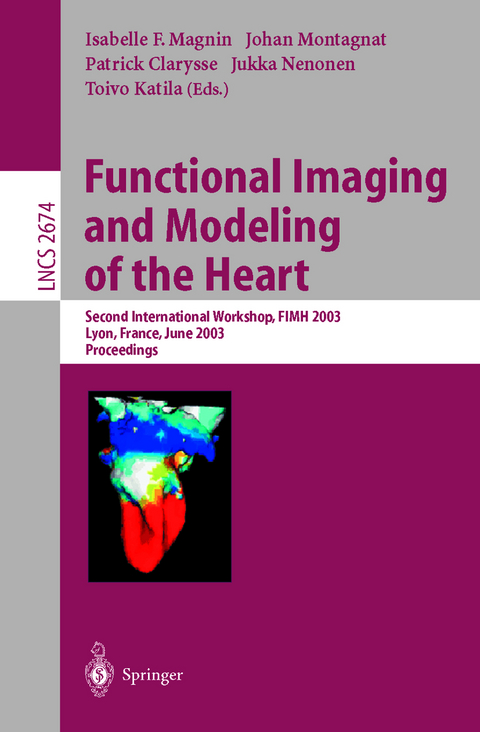
Functional Imaging and Modeling of the Heart
Springer Berlin (Verlag)
978-3-540-40262-6 (ISBN)
Invited Speakers.- Tagged MRI-Based Studies of Cardiac Function.- A Novel Method for Quantifying the Contribution of Different Intracellular Mechanisms to Mechanically Induced Changes in Action Potential Characteristics.- Session 1: Anatomy Extraction and Description.- Automatic Construction of Biventricular Statistical Shape Models.- Visualising Cardiac Anatomy Using Constructive Volume Geometry.- Evaluation of a 3D Segmentation Software for the Coronary Characterization in Multi-slice Computed Tomography.- A Levelset Based Method for Segmenting the Heart in 3D+T Gated SPECT Images.- Session 2: Modeling of the Cardiac Mechanics and Functions.- Modeling of Electro-mechanical Coupling in Cardiac Myocytes: Feedback Mechanisms and Cooperativity.- Simulating Cardiac Mechanoenergetics in the Left Ventricle.- Towards Patient Specific Models of Cardiac Mechanics: A Sensitivity Study.- Does the Collagen Network Contribute to Normal Systolic Left Ventricular Wall Thickening? A Theoretical Study in Continuum Mechanics.- Session 3: Electro-physiology, Electro-, and Magnetography.- Regularization in Cardiac Source Imaging.- On the Influence of a Volume Conductor on the Orientation of Currents in a Thin Cardiac issue.- First 36-Channel Magnetocardiographic Study of CAD Patients in an Unshielded Laboratory for Interventional and Intensive Cardiac Care.- Heterogeneous Sinoatrial Node of Rabbit Heart - Molecular and Electrical Mapping and Biophysical Reconstruction.- Session 4: Motion Estimation.- Construction of a Cardiac Motion Atlas from MR Using Non-rigid Registration.- Motion-Compensation of Cardiac Perfusion MRI Using a Statistical Texture Ensemble.- Measuring Myocardial Deformations in Tagged MR Image Sequences Using Informational Non-rigid Registration.- Parametric Analysis ofMain Motion to Study the Regional Wall Motion of the Left Ventricle in Echocardiography.- Modeling and Tracking of the Cardiac Left Ventricular Motion by a State Space Harmonic Model in MRI Sequence.- Session 5: Image Registration and Image Analysis.- A Strategy to Quantitatively Evaluate MRI/PET Cardiac Rigid Registration Methods Using a Monte Carlo Simulator.- Spatio-temporal Alignment of 4D Cardiac MR Images.- Automatic Registration of MR First-Pass Myocardial Perfusion Images.- Evaluation and Comparison of Surface and Intensity Based Rigid Registration Methods for Thorax and Cardiac MR and PET Images.- Left Ventricular Flow Dynamics and Transmural Gradients in Myofiber Shortening with MRI-Tagging.- Intravascular Ultrasound Images Vessel Characterization Using AdaBoost.- Motion Analysis of 3D Ultrasound Texture Patterns.- Session 6: Data Acquisition, Experimental, and Modeling Studies.- Estimation of the Diastolic Intraventricular Relative Pressures Using MRI Acceleration Measurements.- Magnetic Resonance Fusion Imaging of Chronic Myocardial Ischemia.- The Relationship between Regional Integrated Backscatter Levels and Regional Strain in Normal, Acutely Ischemic, and Reperfused Myocardium.- Why Ischemic Hearts Respond Less to Cardiac Resynchronisation Therapy. A Modeling Study.- Finite Element Models for Mechanical Simulation of Coronary Arteries.
| Erscheint lt. Verlag | 22.5.2003 |
|---|---|
| Reihe/Serie | Lecture Notes in Computer Science |
| Zusatzinfo | XI, 311 p. |
| Verlagsort | Berlin |
| Sprache | englisch |
| Maße | 155 x 235 mm |
| Gewicht | 458 g |
| Themenwelt | Mathematik / Informatik ► Informatik |
| Studium ► 1. Studienabschnitt (Vorklinik) ► Anatomie / Neuroanatomie | |
| Schlagworte | 3D-Imaging • bio-engineering • Cardiac Imaging • Cardiac Modeling • Cardiology • Computed tomography (CT) • Ensembl • Hardcover, Softcover / Informatik, EDV/Informatik • HC/Informatik, EDV/Informatik • Heart Modeling • Herz (anatom.) • Herz (Anatomie) • Image Analysis • Image Processing • medical data acquisition • medical data processing • Medical Image Analysis • MRI • Radiology • Simulation • spatiotemporal data processing • Textur • therapy • Tomography • Ultrasound |
| ISBN-10 | 3-540-40262-4 / 3540402624 |
| ISBN-13 | 978-3-540-40262-6 / 9783540402626 |
| Zustand | Neuware |
| Haben Sie eine Frage zum Produkt? |
aus dem Bereich


